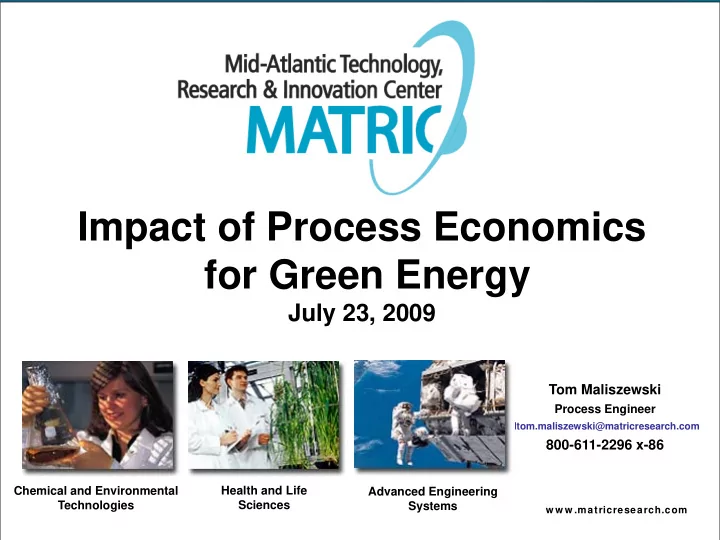

Impact of Process Economics for Green Energy July 23, 2009 Tom Maliszewski Process Engineer dtom.maliszewski@matricresearch.com 800-611-2296 x-86 Chemical and Environmental Health and Life Advanced Engineering Sciences Technologies Systems w w w .matricresearch.com
About MATRIC Research & development corporation formed after Union Carbide merged into Dow Chemical in 2002. Currently MATRIC has a staff of 100+. – 27 PhD-level researchers – 9 professional engineers – 25+ average years of experience MATRIC has a focus to develop intellectual properties for clients, serve commercial and industrial customers, and add genuine value throughout the development process Current work includes biodiesel; other green fuels, plastics, and chemicals; selenium water treatment; gas treating; process safety, developing unique polymers; and much more……. matricresearch.com
Green Fuels and Product Economics Many expended that green fuels and products would be competitive to petro-based fuels when the cost of crude oil reached +/-$100/bbl. But in 2007 and 2008 it was clear that green products were not cost competitive: Higher corn prices caused ethanol to remain no cheaper than gasoline. Less soybean acreage planted and new demand for biodiesel drives up the cost of soybeans and soy oil much higher. Higher corn prices limits bio-plastics to niches instead of competing with commodity petro-plastic. matricresearch.com
Cost Competitive Next Generation Green Products Long term, the cost of production of green products must match cost of petro products for wide acceptability. Consider green raw materials for fuel. Switch to low cost materials, like wood, waste, switchgrass, etc. The bio-processing and the chemical processing must be low cost and high yield. matricresearch.com
Economic Case Study: Cellulosic Ethanol I have devised the final design problem for the senior Purdue University chemical engineering students for about 10 years. For 2008, the professors agreed and I provided a problem to convert an existing corn-fed 100,000,000 gallons per year ethanol plant to a wood raw-material feed. I chose to use the Paszner process* to process wood into sugars which could be used in the fermentation systems of the ethanol plant. The patent has enough information to understand the process. MATRIC had been doing some investigation of this process, so some of the process work was defined. * US Pat 4,470,851, Sept 11, 1984 matricresearch.com
Problem Parameters: This case study is a rough evaluation of a non-food-based raw material to make green fuel. Wood is a much cheaper raw material than corn; wood could allow a bio-fuel price that is competitive with petro-fuel. Wood is a much more difficult to convert to a bio-fuel. The Paszner process uses acetone, water, and acid to break down the cellulose and hemicellulose to sugars, both hexose and pentose. The patent teaches the ratio of the solvent to the wood, and the patent claims that over 98% of the cellulose and hemicellulose are converted to sugars. Example VI of the patent* is the basis of the analysis. * US Pat 4,470,851, Sept 11, 1984 matricresearch.com
Proposed Process The patent uses five steps to recover the sugars, using a total of 500 ml solvent (80% acetone, 20% water, 0.04 normal H 2 SO 4 ) for 10 grams of wood. This process yields 8.81 grams of sugars (78.5% hexose and 21.5% pentose). The patent suggests that the sugars can be separated by distillation of the complex of sugars with acetone. The separated sugars would be sent to the existing ethanol plant, with the hexose sent to some of the fermentators and the pentose to other fermentators. Different yeasts would be needed for each sugar. (New technology may improve this.) matricresearch.com
Process Parameters Plant Basis: Wood cost estimate: $60/ton delivered to site, 30% wet Corn cost estimate: $5/bushel delivered to site Energy cost: $10/millionBTU Ethanol Produced: 12,500 gal/hr (100,000,000 gal/yr) For a commercial plant the flows will be: Solvent Flow Rate: 9,000,000 lb/hr (21,000 gal per min) Wood Feed: 180,000 lb/hr (90 tons/hr) matricresearch.com
Economics of Ethanol Corn vs Wood Feed Convention Ethanol Proposed Ethanol Corn Feedstock Wood Feed Plant Investment $140 million $300-500 million Energy/gal ETOH 33,000 BTU 285,000 BTU Raw Mat’l Cost/gal ETOH $2.17 $0.86 Energy Cost/gal ETOH $0.33 $2.86 Total Cash Cost/gal ETOH $2.50 $3.72
Analysis The Paszner process has problems: The very large solvent flow rate makes the process very expensive. The very large solvent cycle requires very high energy cost. No yeast can convert both sugars; different yeast and segregated fermenters are needed. This increases complexity and extra equipment. The distillation of the acetone-sugar complexes to separate the hexose and pentose is another expensive step. The acid needed for the solvent to break down the wood to sugars requires high alloy construction, increasing plant cost. (New research may offer a fermentation route to convert C5 and C6 sugars to ethanol with the same bug. This would simplify the process significantly.) matricresearch.com
Conclusions The Paszner process can work but that does not mean that the process will be economical. Separations are critical to make the process work. The research is valuable work, but there is very much more work to do to have a competitive technology. In general, green chemistry requires careful design and research. The difficult separations needed for the process can doom commercialization. Skill in separations is critical to synthesize a commercial plant that is competitive against petro-fuels. matricresearch.com
Comments or Questions? Tom Maliszewski Process Engineer dtom.maliszewski@matricresearch.com 800-611-2296 x-86 matricresearch.com
Recommend
More recommend